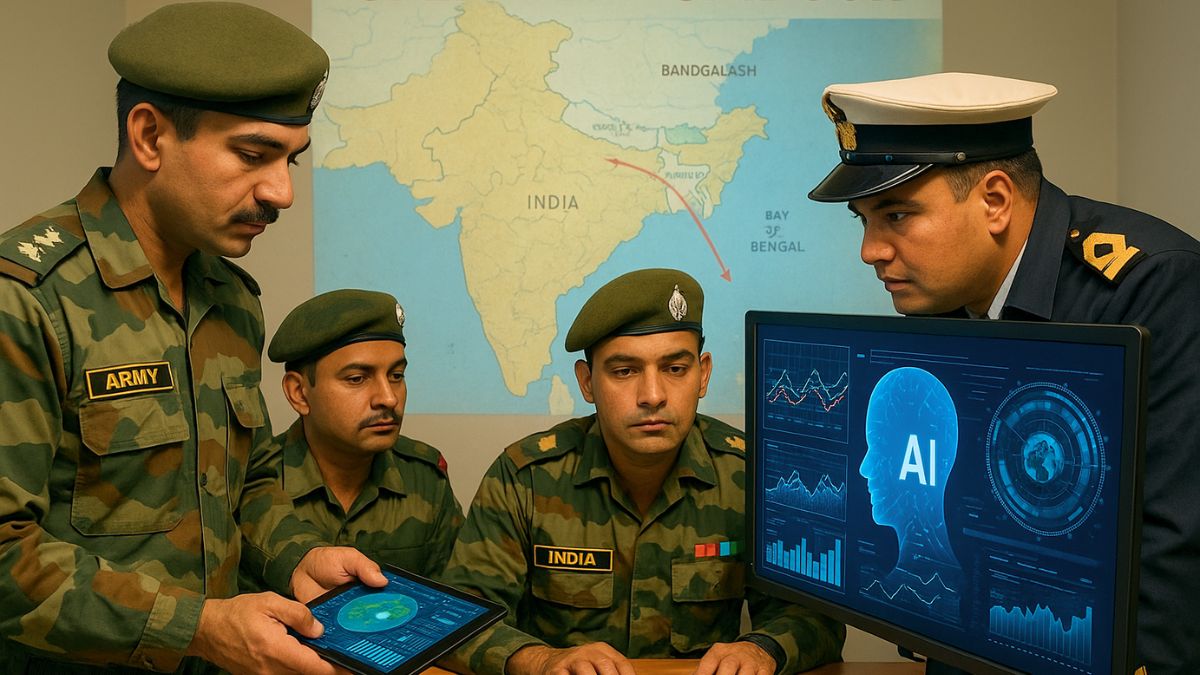There’s no denying that fact that Artificial Intelligence (AI) is being incorporated in almost every field possible, and defence is no exception to that. Chief of Defence Staff General Anil Chauhan had in October 2024 underscored the urgent need to incorporate trustworthy AI, pointing out that recent global conflicts have demonstrated how AI is revolutionising modern warfare.
He even stressed that it is essential to ensure these systems not only work as intended but are also resilient to attacks from adversaries. Just around six months later, the Indian Armed Forces proved that not only can they use AI, but also incorporate it in a way that wins wars.
AI proved to be a decisive enabler during Operation Sindoor, as the Indian Army deployed advanced algorithms to fuse intelligence, analyse threats, and forecast battlefield conditions. From real-time multi-sensor and multi-source data fusion to predictive modelling and weather forecasting for long-range strikes, AI systems formed the backbone of India’s operational dominance.
How AI shaped the battlefield in Op Sindoor?
“AI was extensively used… Overall, 23 apps with specific tasks were used to deal with data and inputs,” revealed Lt-General Rajiv Kumar Sahni, Director General of Electronics and Mechanical Engineers (EME). Central to India’s technological edge were indigenous AI-powered systems such as the Electronic Intelligence Collation and Analysis System (ECAS) and ‘Trinetra’, integrated under Project Sanjay.
While ECAS provided real-time identification and prioritisation of critical threats, Trinetra delivered a common operational picture, enabling commanders to make faster, more informed decisions. Together, these systems ensured decision superiority and strategic dominance across multiple fronts.
Notably, AI was fed with 26 years of historical data, which provided the Indian Army with information on Pakistan military movement. “With this modelling and live feed, 94 percent accuracy was achieved, allowing us to pinpoint where a particular machine, such as a gun or missile unit, would be located on the border,” the officer shared.
What are the key AI initiatives being incorporated by Army?
Home-Grown Application for Electronic Intelligence Collation – This indigenously developed application, used by all intelligence agencies, was modified in record time during Operation Sindoor to meet the customised requirements of various stakeholders and helped in locating adversary sensors.
Precision Targeting – Extended-range meteorological reports available for long-range vectors assisted in precision targeting with the help of AI-enabled Meteorological Reporting Systems.
Common Surveillance Picture and Target Acquisition – The Trinetra System, integrated with Project Sanjay, assisted in the generation of a Common Operational and Intelligence Picture at both tactical and operational levels.
Predictive Threat Modelling Using Artificial Intelligence Framework – It enabled the timely mobilisation of assets for optimal and precise execution at the point of impact.
Whole-of-Nation Approach – The Army’s efforts are fully aligned with key national missions such as Digital India Mission, National Quantum Mission, India Artificial Intelligence Mission – Compute, Artificial Intelligence Research and Development, Development of India’s own sovereign Large Language Model and Small Language Models, Creation of Jigyasa, Establishment of AI as a Service Platform, Operationalisation of the Artificial Intelligence Incubation and Research Centre.
Digitisation Initiatives – Implementation of a comprehensive Data Governance Policy, Rollout of Project Sanjay – Battlefield Surveillance System on the Northern and Western Fronts, Implementation of Project AVAGAT across the Indian Army, Development of 70 digital applications within two years, ensuring application centrality, Introduction of a Data Dictionary to establish a single source of truth.
How is India countering China’s AI-driven warfare push?
In response to China’s rapid militarisation of AI and its reported support to Pakistan with “live” satellite intelligence during the May hostilities, the Indian Army has aligned itself with the IndiaAI Mission, a “whole-of-nation” initiative. Lt-Gen Sahni stressed that the Army is collaborating with industry and academia to develop home-grown AI technologies, ensuring self-reliance in operational, logistics, and autonomous weapon domains.
AI is becoming the new force multiplier in warfare, bringing speed, precision, and lethality to every level of combat. With an 11.5-lakh strong force undergoing digital transformation, the Indian Army is embedding AI into its core operational, intelligence, and logistics systems to stay ahead of emerging threats.
AI-enabled predictive tools also enhanced artillery planning and long-range targeting, allowing units to strike with accuracy even under complex battlefield conditions.
What lies ahead in India’s AI military roadmap?
Following the establishment of the AI Research and Incubation Centre in Bengaluru last year, the Army is now developing a Unified AI Platform, a single secure framework that integrates all operational, intelligence, logistics, and training applications. This platform will replace fragmented systems, enabling validated AI deployment within 24 hours.
It will also create secure, cloud-based and edge-computing environments for battlefield use. In addition to this, dedicated AI cells are also being raised to develop autonomous drones and unmanned vehicles, enhancing both combat effectiveness and troop safety.
Worth noting here is that under the leadership of the Directorate General of Information Systems (DGIS), automation within the Army has led to a remarkable 1,200% increase in users and a 620% rise in data storage capacity.
Why AI is the future of warfare?
Through these initiatives, the Indian Army is steadily moving towards becoming a technology-driven, future-ready force. By embracing automation, digitisation, and AI responsibly, the Army aims to maintain its operational edge, strengthen national security, and contribute meaningfully to the vision of Viksit Bharat 2047.
As Lt-Gen Sahni noted, the Indian Army’s push towards AI is not just about adopting technology, it’s about reshaping the art of war. From reducing risks to soldiers and enabling real-time decision-making to strengthening strategic resilience, AI is emerging as the silent warrior of modern battlefields.
India’s experience in Operation Sindoor demonstrates that wars of the future will not just be fought with weapons, but with intelligence, data, and code.
